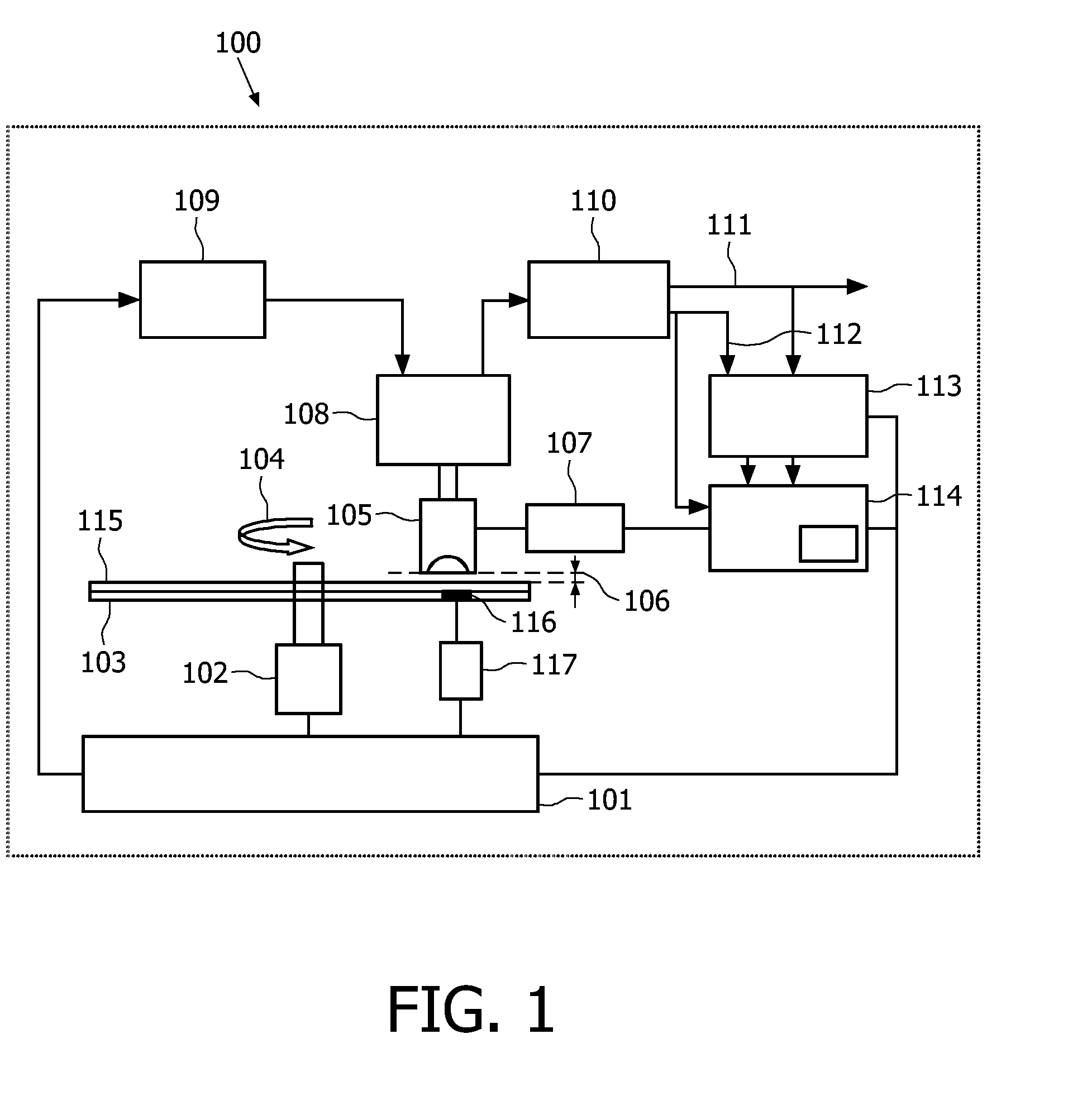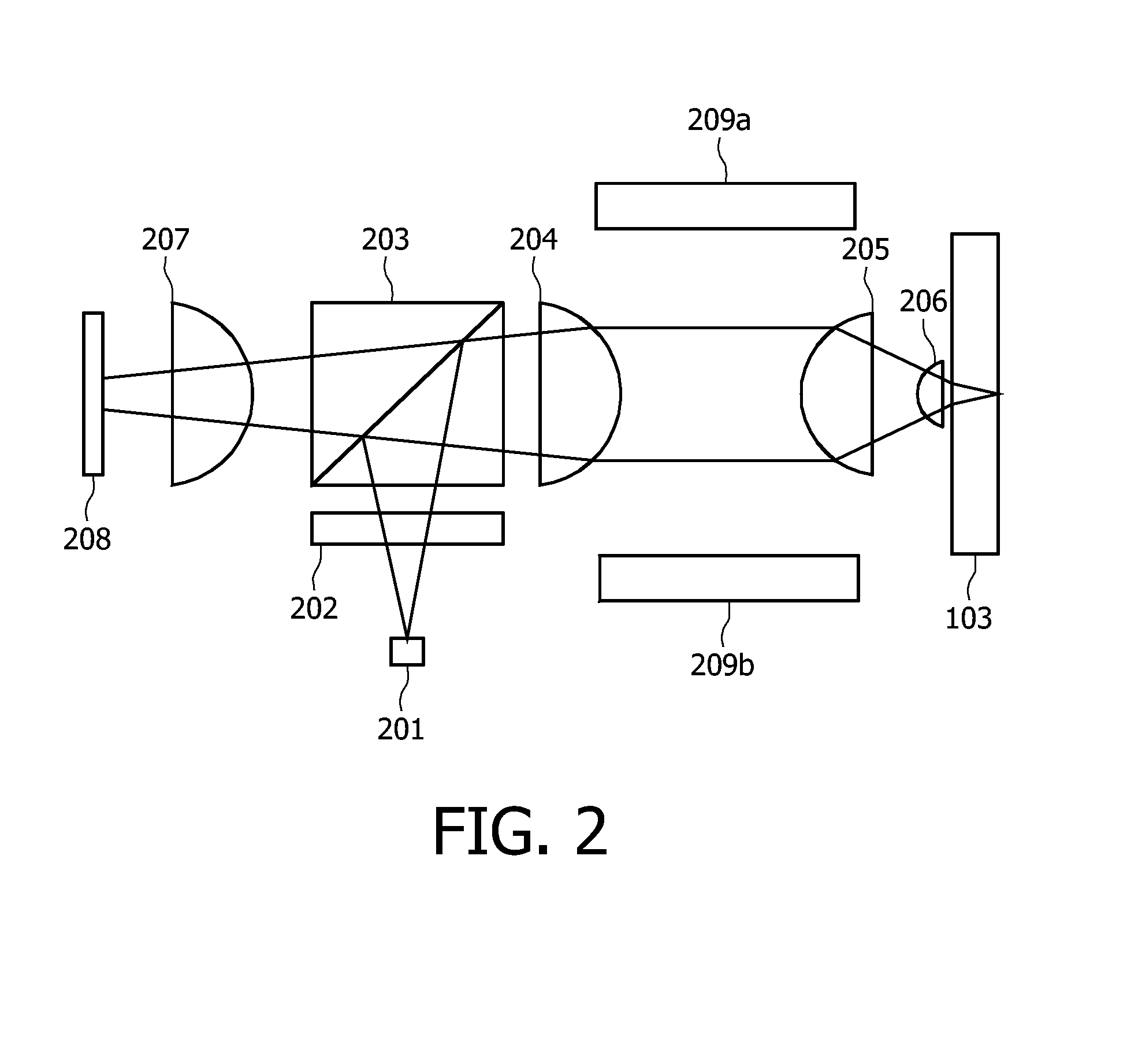Method of Cleaning a Refractive Element and Optical Scanning Apparatus For Nearfield Optical Systems
a technology of optical scanning apparatus and refractive element, which is applied in the direction of instruments, mechanical recording, record information storage, etc., can solve the problems of system sensitive to small contaminants, slider colliding with the disc, and hydrodynamic air pressure, so as to reduce hydrodynamic air pressure, improve cleaning efficiency, and negatively affect the transmission of radiation
- Summary
- Abstract
- Description
- Claims
- Application Information
AI Technical Summary
Benefits of technology
Problems solved by technology
Method used
Image
Examples
first embodiment
[0033]FIG. 4 illustrates a method of cleaning an optical exit surface (302,303) of a refractive element, in particular the SIL lens 206, according to the invention. While scanning an optical disc 115, the very small distance in the order of 20-50 nm between the optical disc 115 and the SIL lens 206 can lead to contamination of the SIL lens 206. This can be due to contamination present on the optical disc 115, residue from small contact / impact events, etc. Although said contamination may not give rise to immediate problems, a large amount of residue increases the chance of contamination or damage to the optical exit surface (302,303) of the SIL lens 206 and, should therefore be avoided. As mentioned, we observed that contamination mainly collects around the edge of the optical exit surface (302,303) of the SIL lens 206. Such contaminant accumulation at the edges of the optical exit surface (302,303) is illustrated in FIG. 4 by means of contamination material 400. Consequently, attemp...
second embodiment
[0041]FIG. 5 illustrates a method of cleaning an optical exit surface (302,303) of a SIL lens 206 according to the invention. Accordingly, a cleaning sequence of corresponding rotation and cleaning steps are performed.
[0042]In FIG. 5a and b, a top view of the optical exit surface (302,303) of a SIL lens 206 and of the cleaning pad 116 are shown. Arrow 503 indicates the possible rotation directions of the SIL lens 206; arrows 505a and 505b indicate the possible movement directions of the cleaning pad 116. Numerals 501 and 501 indicate two edges of the optical exit surface (302,303) of a SIL lens 206 that are being cleaned according to the method. In a first sequence of steps, as illustrated in the top view of FIG. 5b, the SIL lens 206 is rotated in a direction 506 so that edge 511 is a contact edge and edge 512 does not contact the cleaning pad 116. In the first cleaning step, the cleaning pad 116 is moved accordingly, as indicated by arrow 507. In a second sequence of steps, as illu...
third embodiment
[0047]FIG. 6 illustrates a method of cleaning a refractive element according to the invention;
[0048]The concepts as described hereinabove can be extended to cleaning the entire edge of optical exit surface (302,303) of the SIL lens 206, instead of only the (most important) leading and trailing edges. Preferably this is obtained by making use of a 4D actuator, allowing rotating of the SIL lens 206 in two perpendicular directions. FIG. 6 shows from a top view the circular edge of optical exit surface (302,303) of the SIL lens 206. The arrows 606 and 607 indicate the rotation direction available for rotation the SIL lens 206. The dashed axes indicate the possible movement directions of the cleaning pad 116 (for clarity, the cleaning pad 116 is not shown in FIG. 6). For example, in a cleaning method according to a third embodiment of the invention, the method starts by rotating the SIL lens 206 such that the edge of optical exit surface (302,303) is touching the cleaning pad 116 in poin...
PUM
| Property | Measurement | Unit |
|---|---|---|
| Angle | aaaaa | aaaaa |
| Angle | aaaaa | aaaaa |
| Area | aaaaa | aaaaa |
Abstract
Description
Claims
Application Information
 Login to View More
Login to View More - R&D
- Intellectual Property
- Life Sciences
- Materials
- Tech Scout
- Unparalleled Data Quality
- Higher Quality Content
- 60% Fewer Hallucinations
Browse by: Latest US Patents, China's latest patents, Technical Efficacy Thesaurus, Application Domain, Technology Topic, Popular Technical Reports.
© 2025 PatSnap. All rights reserved.Legal|Privacy policy|Modern Slavery Act Transparency Statement|Sitemap|About US| Contact US: help@patsnap.com



